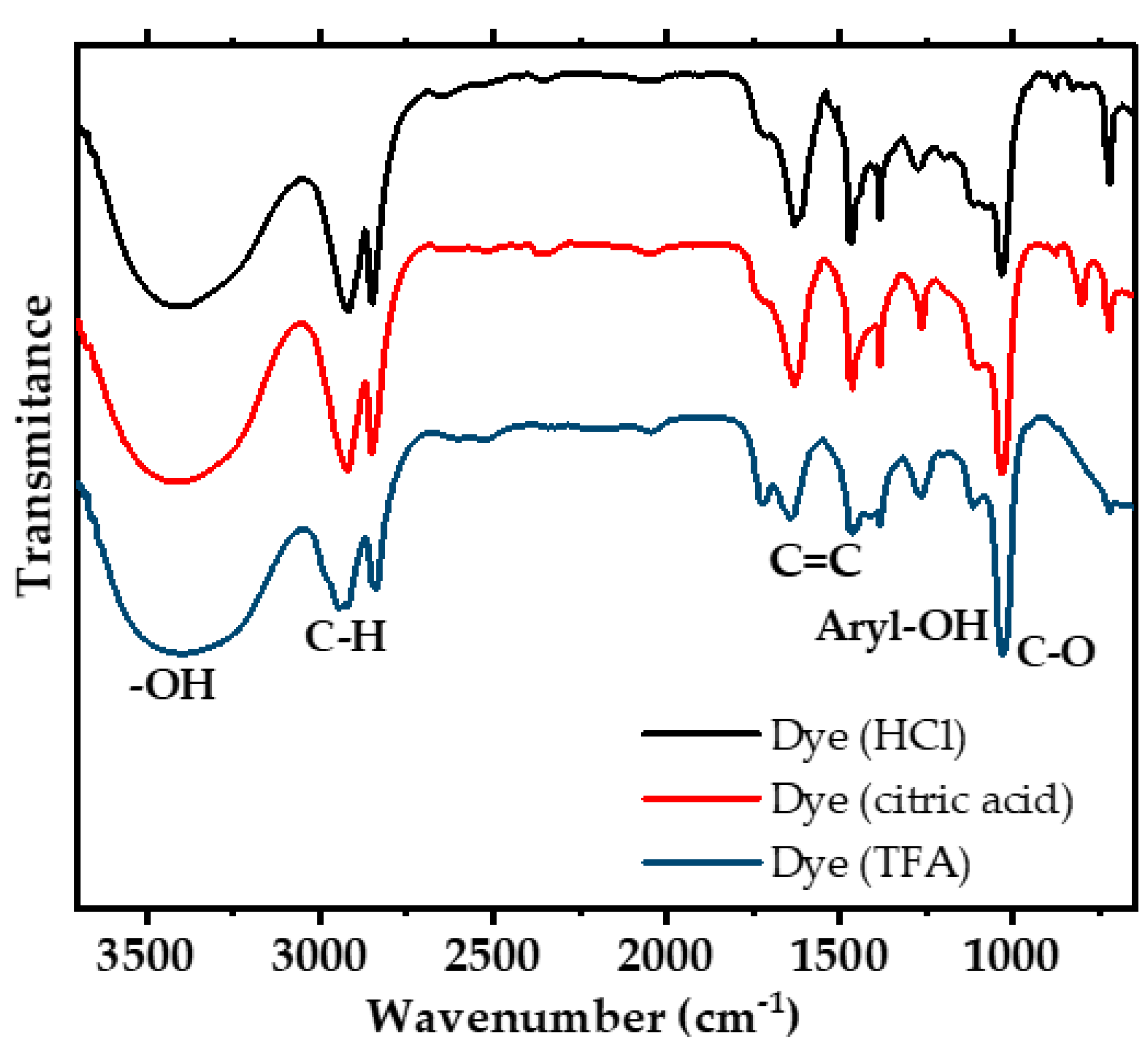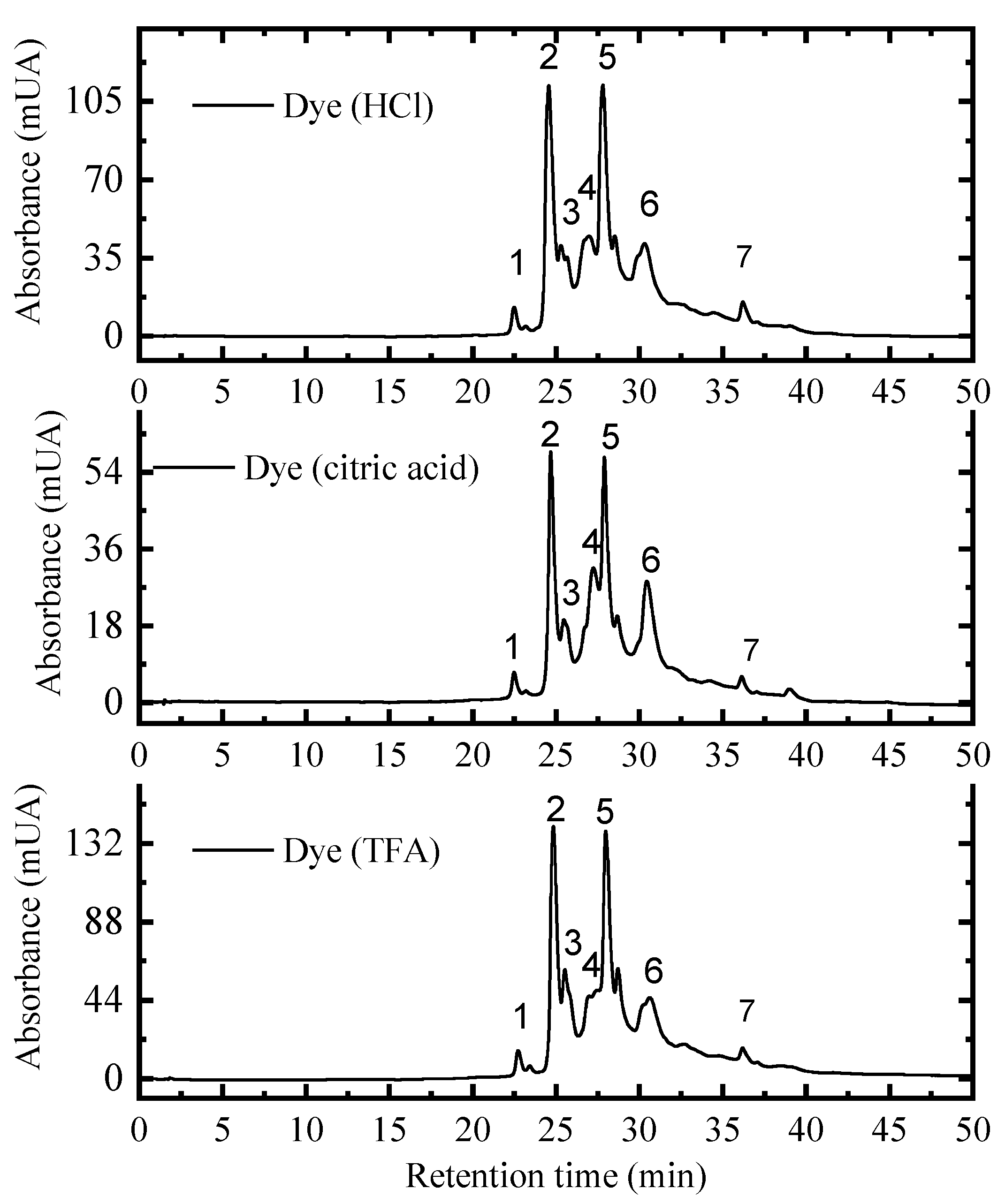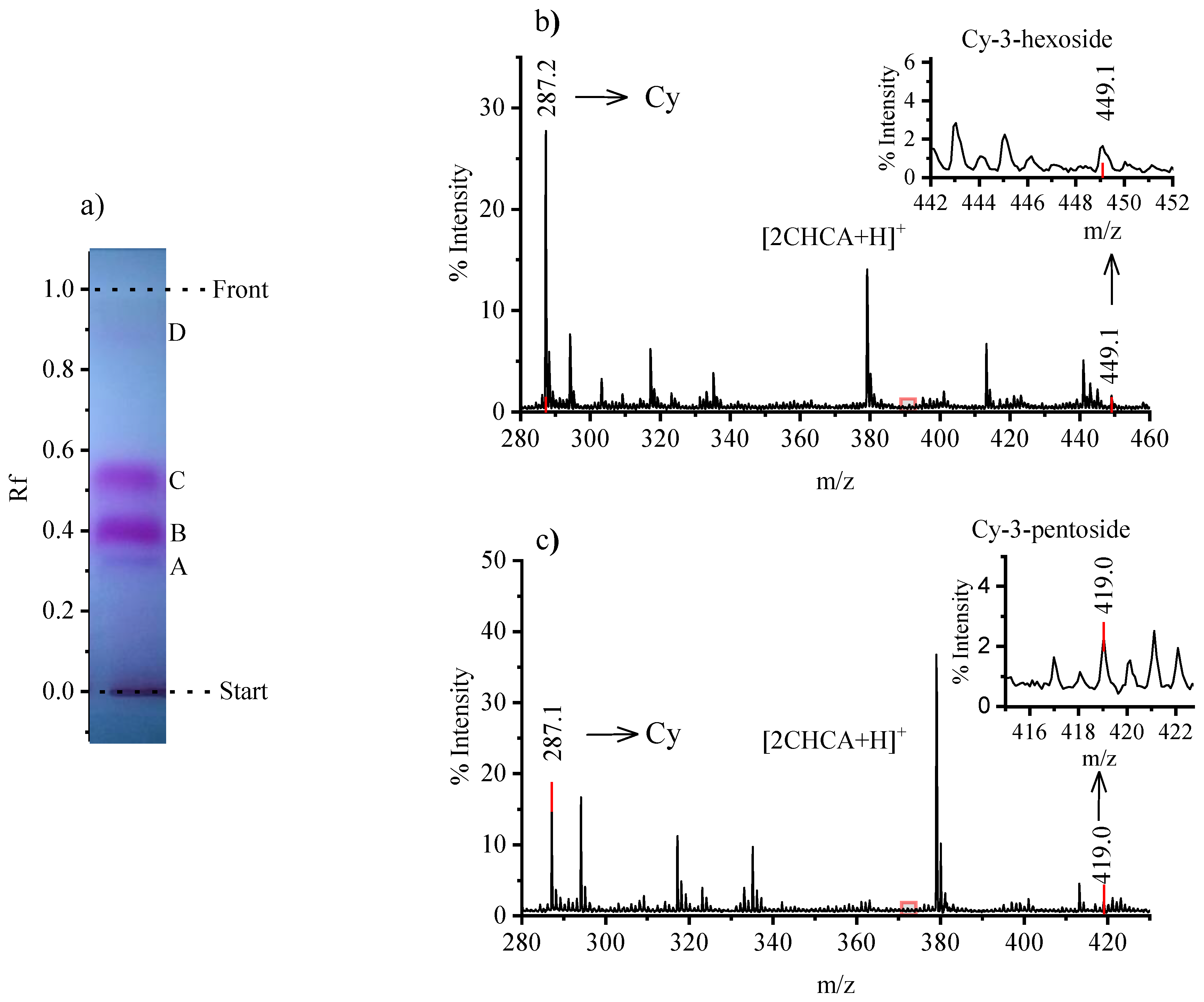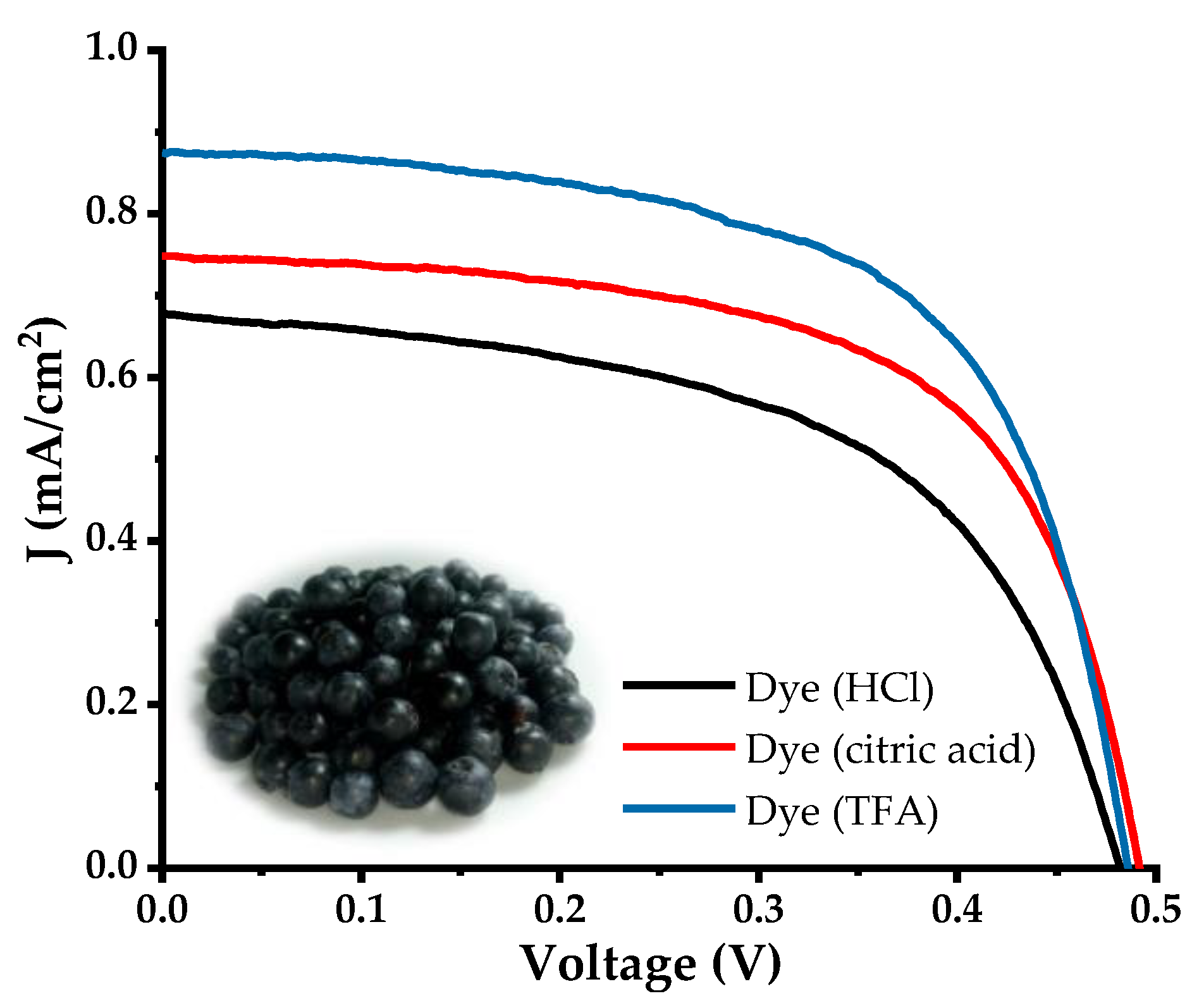Natural Dyes from Mortiño (Vaccinium floribundum) as Sensitizers in Solar Cells
Abstract
:1. Introduction
2. Materials and Methods
2.1. Reagents and Materials
2.2. Dye Extraction and Characterization
2.3. DSSC Construction and Characterization
3. Results and Discussions
3.1. Monomeric Anthocyanin Content
3.2. UV-VIS Spectroscopy
3.3. Infrared Spectroscopy
3.4. High Performance Liquid Chromatography (HPLC)
3.5. Thin Layer Chromatography (TLC) + MALDI
3.6. Characterization of DSSC
4. Conclusions
Author Contributions
Funding
Acknowledgments
Conflicts of Interest
References
- International Energy Agency. CO2 Emissions from Fuel Combustion Highlights. 2017. Available online: http://www.indiaenvironmentportal.org.in/files/file/CO2EmissionsfromFuelCombustionHighlights2017.pdf (accessed on 21 January 2020).
- Babayigit, A.; Ethirajan, A.; Muller, M.; Conings, B. Toxicity of organometal halide perovskite solar cells. Nat. Mater. 2016, 15, 247–251. [Google Scholar] [CrossRef] [PubMed]
- Hsu, D.D.; O’Donoughue, P.; Fthenakis, V.; Heath, G.A.; Kim, H.C.; Sawyer, P.; Choi, J.K.; Turney, D.E. Life Cycle Greenhouse Gas Emissions of Crystalline Silicon Photovoltaic Electricity Generation. J. Ind. Ecol. 2012, 16, S122–S135. [Google Scholar] [CrossRef]
- Tsoutsos, T.; Frantzeskaki, N.; Gekas, V. Environmental impacts from the solar energy technologies. Energy Policy 2005, 33, 289–296. [Google Scholar] [CrossRef]
- Grätzel, M. Dye-sensitized solar cells. J. Photochem. Photobiol. C Photochem. Rev. 2003, 4, 145–153. [Google Scholar] [CrossRef]
- Gong, J.; Sumathy, K.; Qiao, Q.; Zhou, Z. Review on dye-sensitized solar cells (DSSCs): Advanced techniques and research trends. Renew. Sustain. Energy Rev. 2017, 68, 234–246. [Google Scholar] [CrossRef]
- Bagher, A.M. Introduction to Natural Dye Sensitized Solar Cells. Eng. Phys. 2017, 1, 1–7. [Google Scholar]
- Clifford, J.N.; Martínez-Ferrero, E.; Viterisi, A.; Palomares, E. Sensitizer molecular structure-device efficiency relationship in dye sensitized solar cells. Chem. Soc. Rev. 2011, 40, 1635–1646. [Google Scholar] [CrossRef]
- Wang, P.; Klein, C.; Humphry-Baker, R.; Zakeeruddin, S.M.; Grätzel, M. A High Molar Extinction Coefficient Sensitizer for Stable Dye-Sensitized Solar Cells. J. Am. Chem. Soc. 2005, 127, 808–809. [Google Scholar] [CrossRef]
- Wongcharee, K.; Meeyoo, V.; Chavadej, S. Dye-sensitized solar cell using natural dyes extracted from rosella and blue pea flowers. Sol. Energy Mater. Sol. Cells 2005, 91, 566–571. [Google Scholar] [CrossRef]
- Ludin, N.A.; Mahmoud, A.M.A.A.; Mohamad, A.B.; Kadhum, A.A.H.; Sopian, K.; Karim, N.S.A. Review on the development of natural dye photosensitizer for dye-sensitized solar cells. Renew. Sustain. Energy Rev. 2014, 31, 386–396. [Google Scholar] [CrossRef]
- Calogero, G.; Yum, J.H.; Sinopoli, A.; Di Marco, G.; Grätzel, M.; Nazeeruddin, M.K. Anthocyanins and betalains as light-harvesting pigments for dye-sensitized solar cells. Sol. Energy 2012, 86, 1563–1575. [Google Scholar] [CrossRef]
- Calogero, G.; Di Marco, G. Red Sicilian orange and purple eggplant fruits as natural sensitizers for dye-sensitized solar cells. Sol. Energy Mater. Sol. Cells 2008, 92, 1341–1346. [Google Scholar] [CrossRef]
- San Esteban, A.C.M.; Enriquez, E.P. Graphene–anthocyanin mixture as photosensitizer for dye-sensitized solar cell. Sol. Energy 2013, 98, 392–399. [Google Scholar] [CrossRef]
- Nan, H.; Shen, H.P.; Wang, G.; Xie, S.D.; Yang, G.J.; Lin, H. Studies on the optical and photoelectric properties of anthocyanin and chlorophyll as natural co-sensitizers in dye sensitized solar cell. Opt. Mater. 2017, 73, 172–178. [Google Scholar] [CrossRef]
- Teoli, F.; Lucioli, S.; Nota, P.; Frattarelli, A.; Matteocci, F.; Di Carlo, A.; Caboni, E.; Forni, C. Role of pH and pigment concentration for natural dye-sensitized solar cells treated with anthocyanin extracts of common fruits. J. Photochem. Photobiol. A Chem. 2017, 316, 24–30. [Google Scholar] [CrossRef]
- Homeier, J.; Werner, F.A.; Gradstein, S.R.; Breckle, S.W.; Richter, M. Flora and Fungi: Composition and Function BT—Gradients in a Tropical Mountain Ecosystem of Ecuador; Beck, E., Bendix, J., Kottke, I., Makeschin, F., Mosandl, R., Eds.; Springer: Berlin/Heidelberg, Germany, 2008; pp. 87–100. [Google Scholar]
- Council, N.R. Lost Crops of the Incas: Little-Known Plants of the Andes with Promise for Worldwide Cultivation; National Academies Press: Washington, DC, USA, 1989. [Google Scholar]
- Solarte, C.U. Patrimonio Cultural Alimentario; Fondo Editorial Ministerio de Cultura: Quito, Ecuador, 2010. [Google Scholar]
- Vasco, C.; Riihinen, K.; Ruales, J.; Kamal-Eldin, A. Chemical Composition and Phenolic Compound Profile of Mortiño (Vaccinium floribundum Kunth). J. Agric. Food Chem. 2009, 57, 8274–8281. [Google Scholar] [CrossRef]
- Schreckinger, M.E.; Wang, J.; Yousef, G.; Lila, M.A.; De Mejia, E.G. Antioxidant Capacity and in Vitro Inhibition of Adipogenesis and Inflammation by Phenolic Extracts of Vaccinium floribundum and Aristotelia chilensis. J. Agric. Food Chem. 2010, 58, 8966–8976. [Google Scholar] [CrossRef]
- Vizuete, K.S.; Kumar, B.; Vaca, A.V.; Debut, A.; Cumbal, L. Mortiño (Vaccinium floribundum Kunth) berry assisted green synthesis and photocatalytic performance of Silver–Graphene nanocomposite. J. Photochem. Photobiol. A Chem. 2016, 329, 273–279. [Google Scholar] [CrossRef]
- Cherepy, N.J.; Smestad, G.P.; Grätzel, M.; Zhang, J.Z. Ultrafast Electron Injection: Implications for a Photoelectrochemical Cell Utilizing an Anthocyanin Dye-Sensitized TiO2 Nanocrystalline Electrode. J. Phys. Chem. B 1997, 101, 9342–9351. [Google Scholar] [CrossRef]
- Chien, C.Y.; Hsu, B.D. Optimization of the dye-sensitized solar cell with anthocyanin as photosensitizer. Sol. Energy 2013, 98, 203–211. [Google Scholar] [CrossRef]
- Ramamoorthy, R.; Radha, N.; Maheswari, G.; Anandan, S.; Manoharan, S.; Williams, R.V. Betalain and anthocyanin dye-sensitized solar cells. J. Appl. Electrochem. 2016, 46, 929–941. [Google Scholar] [CrossRef]
- Zolkepli, Z.; Lim, A.; Ekanayake, P.; Tennakoon, K. Efficiency Enhancement of Cocktail Dye of Ixora coccinea and Tradescantia spathacea in DSSC. J. Biophys. 2015, 2015, 582091. [Google Scholar] [CrossRef] [PubMed]
- Strauch, R.C.; Mengist, M.F.; Pan, K.; Yousef, G.G.; Iorizzo, M.; Brown, A.F.; Lila, M.A. Variation in anthocyanin profiles of 27 genotypes of red cabbage over two growing seasons. Food Chem. 2019, 301, 125289. [Google Scholar] [CrossRef] [PubMed]
- Lee, J.; Durst, R.; Wrolstad, R. Determination of total monomeric anthocyanin pigment content of fruit juices, beverages, natural colorants, and wines by the pH differential method: Collaborative Study. J. AOAC Int. 2005, 88, 1269–1278. [Google Scholar] [CrossRef] [PubMed] [Green Version]
- Rodriguez-Saona, L.E.; Wrolstad, R.E. Extraction, Isolation, and Purification of Anthocyanins. Curr. Protoc. Food Anal. Chem. 2001. [Google Scholar] [CrossRef]
- Durst, R.W.; Wrolstad, R.E. Separation and Characterization of Anthocyanins by HPLC. Curr. Protoc. Food Anal. Chem. 2001. [Google Scholar] [CrossRef]
- Santacruz, C.P.; Håkansson, P.; Barofsky, D.F.; Piyadasa, C.K.G. A Constant-Momentum/Energy-Selector Time-of-Flight Mass Spectrometer. J. Am. Soc. Mass Spectrom. 2007, 18, 92–101. [Google Scholar] [CrossRef] [Green Version]
- Siegelman, H.W.; Hendricks, S.B. Photocontrol of Alcohol, Aldehyde, and Anthocyanin Production in Apple Skin. Plant Physiol. 1958, 33, 409–413. [Google Scholar] [CrossRef]
- Giusti, M.M.; Wrolstad, R.E. Characterization and Measurement of Anthocyanins by UV-Visible Spectroscopy. Curr. Protoc. Food Anal. Chem. 2001. [Google Scholar] [CrossRef]
- Harborne, J.B. Spectral methods of characterizing anthocyanins. Biochem. J. 1958, 70, 22–28. [Google Scholar] [CrossRef]
- Fernando, J.M.R.C.; Senadeera, G.K.R. Natural anthocyanins as photosensitizers for dye-sensitized solar devices. Curr. Sci. 2008, 95, 663–666. [Google Scholar]
- Hao, S.; Wu, J.; Huang, Y.; Lin, J. Natural dyes as photosensitizers for dye-sensitized solar cell. Sol. Energy 2006, 80, 209–214. [Google Scholar] [CrossRef]
- Jackman, R.L.; Yada, R.Y.; Tung, M.A. A review: Separation and chemival properties of anthocyanins used for their qualitative and quantitative analysys. J. Food Biochem. 1987, 11, 279–308. [Google Scholar] [CrossRef]
- Murayama, M.; Mori, T. Equivalent Circuit Analysis of Dye-Sensitized Solar Cell by Using One-Diode Model: Effect of Carboxylic Acid Treatment of TiO2 Electrode. Jpn. J. Appl. Phys. 2006, 45, 542–545. [Google Scholar] [CrossRef]
- Obasuyi, A.R.; Glossman-Mitnik, D.; Flores-Holguín, N. Electron injection in anthocyanidin and betalain dyes for dye-sensitized solar cells: A DFT approach. J. Comput. Electron. 2019, 18, 396–406. [Google Scholar] [CrossRef]
- Lakshmanakumar, M.; Sriram, S.; Balamurugan, D. Performance analysis of TiO2-flavylium compound-based dye-sensitized solar cell (DSSC): A DFT–TDDFT approach. J. Comput. Electron. 2018, 17, 1143–1152. [Google Scholar] [CrossRef]





| Extraction Acid | Efficiency (% η) | JSC (mA/cm2) | VOC (V) | FF |
|---|---|---|---|---|
| AC | 0.23 ± 0.05 a,b | 0.75 ± 0.15 a | 0.490 ± 0.007 a | 0.62 ± 0.03 a |
| HCl | 0.18 ± 0.03 a | 0.68 ± 0.20 a | 0.475 ± 0.012 b | 0.57 ± 0.06 a |
| TFA | 0.26 ± 0.05 b | 0.88 ± 0.17 a | 0.485 ± 0.007 a,b | 0.62 ± 0.04 a |
| ANOVA P | 0.027 | 0.181 | 0.035 | 0.156 |
© 2020 by the authors. Licensee MDPI, Basel, Switzerland. This article is an open access article distributed under the terms and conditions of the Creative Commons Attribution (CC BY) license (http://creativecommons.org/licenses/by/4.0/).
Share and Cite
Taco-Ugsha, M.A.; Santacruz, C.P.; Espinoza-Montero, P.J. Natural Dyes from Mortiño (Vaccinium floribundum) as Sensitizers in Solar Cells. Energies 2020, 13, 785. https://doi.org/10.3390/en13040785
Taco-Ugsha MA, Santacruz CP, Espinoza-Montero PJ. Natural Dyes from Mortiño (Vaccinium floribundum) as Sensitizers in Solar Cells. Energies. 2020; 13(4):785. https://doi.org/10.3390/en13040785
Chicago/Turabian StyleTaco-Ugsha, Miguel A., Cristian P. Santacruz, and Patricio J. Espinoza-Montero. 2020. "Natural Dyes from Mortiño (Vaccinium floribundum) as Sensitizers in Solar Cells" Energies 13, no. 4: 785. https://doi.org/10.3390/en13040785
APA StyleTaco-Ugsha, M. A., Santacruz, C. P., & Espinoza-Montero, P. J. (2020). Natural Dyes from Mortiño (Vaccinium floribundum) as Sensitizers in Solar Cells. Energies, 13(4), 785. https://doi.org/10.3390/en13040785







